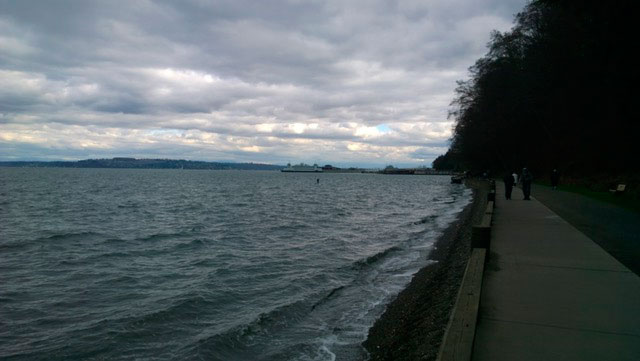By Morf Morford
Tacoma Daily Index
As I was approaching high school graduation, a constant topic of conversation was the next step in each student’s life. As with every graduating class, options included work, travel and further schooling. The one enduring theme was weather. Every single student wanted an escape from our non-stop, seemingly eternal, dreary weather. The longing was not only for warmer, drier weather but for distinct seasons.
I was born and raised here, and have spent most of my life here. I’ve travelled a bit – or at least enough to compare our weather with other places. Yes, our weather can be numbing if not depressing.
If you’ve experienced rain in the Midwest or South, you quickly realize that our rain is completely different. We live in what professional weather people call a “drizzle belt” – we get a lot of rain – but not that much on any given day.
The Gulf states – Alabama and Mississippi in particular – get far more rain than we do – but they usually get it all at once (the record for rainfall is 42 inches in one 24 hour period goes to Texas thanks to Tropical Storm Claudette in 1979. It was more but the rain gauge overflowed.)
If you want to see how rain is measured – or want to measure it on your own, check out this article – https://www.quickanddirtytips.com/education/math/how-is-rainfall-measured.
In the Midwest a rainstorm blows through and dumps a huge amount of rain, but an hour later you’d never know that it ever rained. Unless you were caught in the deluge, you might miss it entirely; in an office for example.
Our rain, on the other hand, feels like part of the landscape. The rain clouds just seem to linger. In fact on our proto-typical Pacific Northwest day, we don’t even have clouds – we have a solid grey-whitish indefinable presence – a horizon to horizon mass with no ending and no beginning and no defining features at all. It is a pale grey blur that hovers over us. There are no shadows on those days. No sun is visible. It is as if time is standing still. It could be November, or February, or April. It could be winter – or spring – or fall – or even summer.
That might be the reason you see so few sundials here.
In other parts of the world trees lose their leaves. Most of our trees are evergreens so they look the same throughout the year.
Montana calls itself “Big sky country” for good reason. Our horizons are limited as much by trees as by building or even hills, open skies are fairly unusual around here – even though views are plentiful.


If the sky and the earth look the same season to season – no wonder we are a bit disoriented when it comes to time management – and no wonder young adults are eager to see those sunny skies.
If the earth and sky look essentially the same no matter what season, how people dress will be even less helpful to define a season. Have you noticed how many adults wear shorts throughout the winter months? Or how about those who wear a heavy parka or hoodie – with shorts – on a winter day? Or how about those who wear a hoodie (or sometimes two!) on a sweltering (for us) summer day?
I used to teach GED math. One of the problems I developed was how to measure rain. For example, if it rains one inch, how much water is that? As you might imagine several people – especially those who work in agriculture – keep track of such things. Here’s a simplified version – one inch of rainfall is enough to create a one inch deep layer of water on your roof – or property or your town. The total volume of water on your roof is the square footage of your roof—let’s say it’s 1,000 square feet—times one inch equals 1/12 of a foot. That’s about 83.3 cubic feet of water per inch of rain for a 1,000 square foot roof.
How many gallons is that? There are just about 7.5 gallons in a cubic foot. Which means that a 1,000 square foot roof is bombarded by 83.3 x 7.5 or about 625 gallons of water per inch of rain. How much is that? Those big metal drums used to transport oil or almost any liquid are 55 gallons. So if you could collect all of that water, you could fill almost 11.5 barrels from a single inch of rain.
And just a reminder, if you’ve ever carried a gallon bottle of water, you know they are heavy – but did you know how heavy? Each gallon of water weighs a little over eight pounds (8.34 pounds to be exact).
If you multiply that one inch by the nearly 50 square miles of the city of Tacoma, you quickly realize that those fluffy clouds are not so fluffy after all – they are massive floating sponges holding literally tons of water over us.
The irony about our rain though, is that it only takes a short dry spell for most of us to miss it.
True locals start feeling a bit stressed if we don’t see rain for a week or so.
There is something comforting about the misty drizzle that we can’t define – and outsiders will never understand.
We in the Pacific Northwest drink more coffee, read more books, watch more movies and have more pairs of sunglasses (probably because we lose them) than the rest of the country.
Our weather defines us. We may curse the rain, but we don’t have to shovel it or scrape it off our windshields. Besides the rare flood and the even more rare landslides, damage or injury due to local rain barely exists.
Our weather might be unpredictable and ambiguous – but that’s what I love about it.
We don’t have distinct seasons – we have distinct moments.
To quote a phrase, we could “Live like the mountain is out” but I find myself more attracted to the idea of “Live as if the mountain is there whether we can see it or not.” If there is one thing we know for certain about our weather, it is that it is always in motion. Yes, grab those sunny moments, but don’t be afraid of those misty, gray days. You might not have a panoramic view, but if you look – or listen – closely, you just might something even better.
April of 2018 will certainly go down in history as one of the wettest months ever recorded here, but that’s all right, we do have a reputation to uphold.
And those high school students? Almost all of them, after experiencing droughts, fires, floods or blizzards in other parts of the country have done their best to move back to our relatively benign weather.








